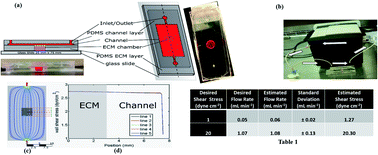Shear stress magnitude and transforming growth factor-βeta 1 regulate endothelial to mesenchymal transformation in a three-dimensional culture microfluidic device†
Abstract
Normal fibroblasts are present within the extracellular matrix (ECM). They can become activated, leading to increased proliferation and ECM protein secretion such as collagen type I to promote tissue remodeling. These cells are also involved in adult pathologies including cancer metastasis and cardiac and renal fibrosis. One source of activated fibroblasts is endothelial to mesenchymal transformation (EndMT), in which endothelial cells lose their cell–cell and cell–ECM adhesions, gain invasive properties, and become mesenchymal cells. While EndMT is well characterized in developmental biology, the mechanisms and functional role of EndMT in adult physiology and pathology have not been fully investigated. A microfluidic device with an incorporated three-dimensional ECM chamber was developed to study the role of combined steady fluid shear stress magnitudes and transforming growth factor-βeta 1 (TGF-β1) on EndMT. Low (1 dyne per cm2) steady shear stress and TGF-β1 exposure induced EndMT in endothelial cells, including upregulation of mesenchymal protein and gene expression markers. Cells exposed to TGF-β1 and high (20 dynes per cm2) steady shear stress did not undergo EndMT, and protein and gene expression of mesenchymal markers was significantly downregulated. Mesenchymally transformed cells under static conditions with and without TGF-β1 showed significantly more collagen production when compared to fluidic conditions. These results confirm that both low shear stress and TGF-β1 induce EndMT in endothelial cells, but this process can be prevented by exposure to physiologically relevant high shear stress. These results also show conditions most likely to cause tissue pathology.


 Please wait while we load your content...
Please wait while we load your content...